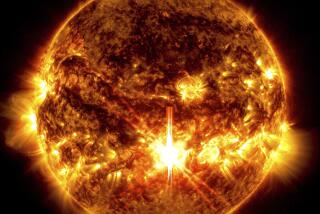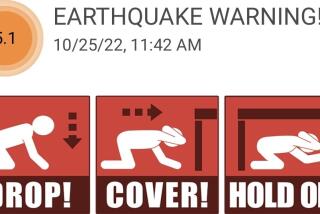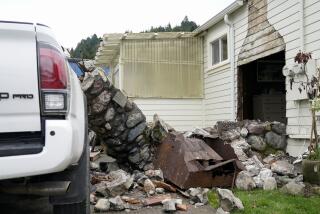Latest Lookout for Bad Weather
CLEVELAND NATIONAL FOREST — You probably didn’t notice, but over the past year you’ve had a gap filled that will make it easier for you to deal with whatever mayhem El Nino kicks up this winter.
And for this little improvement in the quality of your life, you can thank an 86-foot-high radar tower, which looks like a giant softball on an oil derrick, near Pleasants Peak off Black Star Canyon Road.
With minimal fanfare, the National Weather Service last year switched on the seventh and final tower in its Doppler radar system in California, part of a national network designed to improve weather forecasting.
The new tower covers the coastal area--primarily Orange County--previously not reached by existing towers near Oxnard and San Diego.
Now, weather service officials say, they’ll be able to issue more accurate warnings this winter as storms make their way inland from the Pacific Ocean.
“We’re really going to be counting on these radars,” said Armando Garza, meteorologist in charge of the weather service’s San Diego regional office.
“We’ve been making sure they’re properly maintained and ready to go, so they don’t go down during the time we really need them.”
With the Doppler system, meteorologists can measure the density of rain, the strength of
winds and other details that allow them to fine-tune their predictions. So as El Nino unleashes winter storms, forecasters will be able to issue more specific warnings about levels of rainfall.
“It’s superior technology,” Garza said. “It’s highly sensitive, and it provides us some very site-specific information. Older radars painted the rain on the screen, an indication of an area. This one actually gives us a better pinpoint of where the heavy rains are occurring.”
The system mixes computerized mathematical formulas called algorithms with regular radar to measure storms as far as 200 miles offshore. It converts the readings into assessments of rainfall and likely storm paths.
“Before, we knew that storms were coming in because we had a satellite picture,” Garza said. “That did not give us a good indication as to what was embedded. If rain was occurring in Santa Ana, we knew it was occurring but didn’t have a feel as to how much. Doppler radar can actually pick out the different storms coming in that train of cloudiness.
“If it’s four or five inches, then we can issue warnings for flash flooding.”
The Doppler system is named for the Doppler effect, the phenomenon identified in 1842 by Austrian physicist Christian Johann Doppler. Its effect is that sound and light waves seem to increase as objects approach each other.
Recent rains spawned by Hurricane Nora gave the new Doppler tower a workout. Garza said forecasters were able to use information from the tower to issue flash flood warnings in Riverside and San Bernardino counties, as moist tropical air blew over the flat lands of Orange County, hit the mountains and developed into downpours farther inland.
“It worked out fine,” Garza said.
Other towers along the coast are at Scripps Ranch in San Diego County, Sulfur Mountain near Oxnard, Mt. Umunhum near San Jose, Hanford, Davis and Ferndale near Eureka. Four other towers in Medford, Ore., Reno, Las Vegas and Yuma, Ariz., augment the California system, tracking storms as they move eastward.
Each tower cost about $1.5 million to put up, Garza said, though the Orange County tower cost about $2 million.
“We had to rework the road just to get the equipment up there,” Garza said.
(BEGIN TEXT OF INFOBOX / INFOGRAPHIC)
Rain Radar
During the upcoming El Nino season, weather forecasters are expecting to predict which cities will receive the most rain and pinpoint potential flood zones prior to storms. Their crystal ball: a Doppler radar system called the Next-Generation Radar System, or NexRad. The sophisticated tower, able to determine the amount of rain in a cloud, was installed near the top of Black Star Canyon Road near Irvine Lake in 1996. How it works:
Inside the Tower
The radar unit is mounted on an 86-foot tower. Inside the radome, a transmitter sends electromagnetic pulses in all directions. A 28-foot-wide receiving dish, acting as an “electronic ear,” listens for pulse echoes as they bounce off airborne dust and rain droplets. Variations in wavelengths of returning echoes are analyzed by computers to determine storm location, wind speed and direction, and amount of rain embedded in a storm cloud. The dish can pick up echoes from ground level to 70,000 feet and the impulses can cover a distance of 250 miles.
Sizing Up a Storm
Old System
Before Doppler, weather forecasters relied on Federal Aviation Administration radar, which captured only motion. The murky images provided little information beyond a storm’s outline and its general direction of movement.
Doppler System
Results of the computer analysis are color-coded to identify a variety of wind conditions and amount of rain in a storm cell, enabling forecasters to determine storm intensity. The system can also locate river basins to show where rainfall will drain and provide warning of potential floods.
Big Picture
Southern California now has four Doppler radar towers, enabling forecasters to make predictions three to five days in advance as well as to interpret information during storms to alert specific cities and areas of a fast-forming storm. Tower locations:
1. Poway
2. South of Irvine Lake
3. Southwest of Corona
4. North of Oxnard
Sources: National Weather Service, Times reports
Researched by APRIL JACKSON / Los Angeles Times
More to Read
Sign up for Essential California
The most important California stories and recommendations in your inbox every morning.
You may occasionally receive promotional content from the Los Angeles Times.











